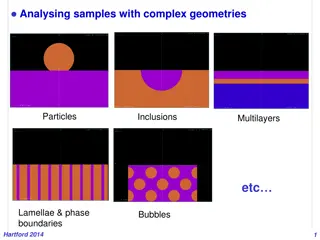Introduction to Abstraction Techniques using Foxes and Rabbits Simulation
Explore the benefits of simulation in predicting wildlife impact and balance in predator-prey relationships through a Java program simulating foxes and rabbits. Learn about important classes, behaviors of rabbits, and the overall simulation setup.
- Abstraction Techniques
- Predator-Prey Simulation
- Java Programming
- Foxes and Rabbits
- Object-oriented Programming
Download Presentation

Please find below an Image/Link to download the presentation.
The content on the website is provided AS IS for your information and personal use only. It may not be sold, licensed, or shared on other websites without obtaining consent from the author. Download presentation by click this link. If you encounter any issues during the download, it is possible that the publisher has removed the file from their server.
E N D
Presentation Transcript
DIN61-222 Adv. Prog. (Java) Semester 1, 2019-2020 10. More Abstraction Techniques Objectives use a foxes-and-rabbits simulation to introduce abstract classes, interfaces, and multiple inheritance 1
1. Benefits of Simulation Use to make predictions: the weather, the stock market, traffic systems, nuclear processes safer, cheaper, quicker Example: How will the wildlife be affected if we build a road through a park? 2
Predator-prey Simulations There is often a natural balance between wild animals which varies over time. e.g. rabbits e.g. foxes 3
2. Foxes and Rabbits Simulation application details are not important 4
The Important Classes Fox for simulating foxes (the predators) Rabbit for simulating rabbits (the prey) Simulator manages the overall simulation holds collections of foxes and rabbits Field the field where the foxes and rabbits live Location a 2D position in the field 5
Simulator Running Rabbits = orange/yellow Foxes = blue 6
Rabbit public class Rabbit { // fields . . . private int age; private boolean alive; // alive or not? private Location location; // position in field // methods . . . public void act(Field f, List<Rabbit> rs) { ... } } 7
A Rabbits Behaviour Implemented in Rabbit.act(): a rabbit gets older when act() is called it may die of old age a rabbit may create new rabbits a rabbit tries to move to an empty adjacent square in the field overcrowding will kill a rabbit 8
The details are not important. Rabbit.act() public void act(Field f, List<Rabbit> rs) /* A rabbit has babies, moves about, or dies of old age or overcrowding. */ { incrementAge(); // may die if (isAlive) { // have rabbit make babies for (int i = 0; i < numBabies(); i++) { Rabbit r = new Rabbit(); Location loc = f.nextTo(location); f.moveTo(r, loc); // add new rabbit to field rs.add(r); } : continued 9
// try to move this rabbit Location newLoc = f.nextTo(location); if (newLoc != null) // if new location is free f.moveTo(this, newLoc); else // can't move - so die isAlive = false; } } // end of act() 10
Fox public class Fox { // fields. . . private int age; private boolean alive; // alive or not? private Location location; // position in field private int foodLevel; // increased by eating rabbits // methods . . . public void act(Field f, List<Fox> fxs) { ... } } 11
A Foxs Behavior Implemented in Fox.act(): a fox gets older and hungrier when act() is called it may die of old age or hunger a fox may create new foxes a fox tries to move to a food (rabbit) location or an empty adjacent square in the field overcrowding will kill a fox 12
The details are not important. Fox.act() public void act(Field f, List<Fox> fxs) /* A fox makes babies, moves about looking for food, or dies of old age, hunger, or overcrowding. */ { incrementAge(); // may die incrementHunger(); // may die if (isAlive) { // have fox make babies for (int i = 0; i < numBabies(); i++) { Fox fx = new Fox(); Location loc = f.nextTo(location); f.moveTo(fx, loc); // place new fox in field fxs.add(fx); } : continued13
// try to move this fox Location newLoc = findFood(f, location); if (newLoc == null) // if no food then move randomly newLoc = f.nextTo(location); if (newLoc != null) // if new location is free f.moveTo(this, newLoc); else // can't move - so die isAlive = false; } } // end of act() 14
Simplified Simulator Code ArrayList<Fox> fxs = new ArrayList<Fox>(); ArrayList<Rabbit> rs = new ArrayList<Rabbit>(); Field f = new Field(); populate(f, fxs, rs); // fill the field with foxes and rabbits at random locs while (true) { // update the simulation by one time unit for(Rabbit r : rs) r.act(f, rs); for(Fox fx : fxs) fx.act(f, fxs); : } 15
3. Improving the Code Place common fields and methods of Rabbit and Fox in a superclass called Animal Simulatorcan now be simplified by using a single list of animals 16
Simplified Simulator Code ArrayList<Animal> animals = new ArrayList<Animal>(); Field f = new Field(); populate(f, animals); // fill the field with foxes and rabbits at random locs while (true) { // update the simulation by one time unit for(Animal a : animals) a.act(f, animal); : } 17
Class Diagrams uses is a 18
Animal.act() There must be an act() method in Animal. But it's not clear what code should go in act(), since the behaviours of Rabbit and Fox are different continued19
Instead of writing an Animal.act() method which does nothing useful, define it as abstract: abstract public void act(Field f, List<Animal> as); // no body code for act() This makes the Animal class become abstract. 20
The Animal Abstract Class public abstract class Animal { // fields . . . abstract public void act(Field f, List<Animal> as); // no body code for act() // other (ordinary) methods . . . } 21
Abstract Classes and Methods An abstract method has no body code i.e. the method has no implementation Abstract classes cannot be used to create objects e.g. you cannot write: Animal a = new Animal(); continued22
Subclasses of an abstract class should implement the abstract methods e.g. Rabbit and Fox should implement act() Rabbit and Fox are called concrete classes If a subclass does not implement act() then it becomes abstract (just like Animal), and so cannot create objects. 23
4. More Powerful Simulator uses is a abstract classes concrete classes 24
The Actor Abstract Class The Actor class contains the common parts of all actors, including an abstract act() method. public abstract class Actor { // fields . . . abstract public void act(Field f, List<Actor> as); // no body code for act() // other (ordinary) methods . . . } 25
Animal extends Actor, but is still abstract: public abstract class Animal extends Actor { // fields . . . abstract public void act(Field f, List<Actor> as); // no body code for act() // other (ordinary) methods . . . } 26
Hunter extends Actor, and supplies code for act(): public class Hunter extends Actor { // fields . . . public void act(Field f, List<Actor> as); { // code for Hunter behaviour ... } // other methods . . . } 27
5. From Abstract to Interface If an abstract class is so general that it has no data fields, and no ordinary methods, then it can be changed into an interface 28
An Actor Interface public interface Actor { void act(Field f, List<Actor> as); } All the methods in an interface are public and abstract by default so no need to include publicand abstract keywords There is no constructor. 29
Classes and Interface Summary A (ordinary) Class. All methods have implementations. Can create objects. An Abstract Class. Some methods have implementations; the methods with no implementations are abstract. Cannot create objects. An Interface No methods have implementations. No data. 30
Using an Interface An interface is inherited with the keyword implements (not extends). The subclass must implement all of the methods in the interface. continued31
Hunter implements the Actor interface by supplying code for act(): public class Hunter implements Actor { // fields . . . public void act(Field f, List<Actor> as); { code for Hunter behaviour ... } // other methods . . . } 32
6. Why have Interface Types? There are three main reasons for using interfaces: to support polymorphism 1. to implement multiple inheritance 2. to allow classes to offer different implementations for the same thing 3. 33
6.1. Why have Interface Types? (1) When a class implements an interface, it becomes the interface's subclass, and must implement all the interface methods and this allows objects to be grouped together and manipulated more easily 34
Example public interface Insurable // methods required to make an class insurable { void setRisk(String risk); String getRisk(); } 35
An Insurable Car public class InsurableCar implements Insurable { private String type; private int yearMade; private Color colour; // other fields related to cars... private String riskKind; public InsurableCar(String t, int y, Color c) { type = t; yearMade = y; colour = c; riskKind = "Third Party, fire and theft"; } // end of InsurableCar() public String toString() { return "CAR: " + colour + ", " + type + ", " + yearMade; } // other methods related to cars... continued36
These methods MUST be here since InsurableCar implements Insurable. public void setRisk(String risk) { riskKind = risk; } public String getRisk() { return riskKind; } } // end of InsurableCar class 37
An Insurable House public class InsurableHouse implements Insurable { private int yearBuilt; private int numRooms; // other fields related to houses... private String riskKind; public InsurableHouse(int y, int nr) { yearBuilt = y; numRooms = nr; riskKind = null; } // end of InsurableHouse() public String toString() { return "HOUSE: " + numRooms + ", " + yearBuilt; } // other methods related to houses... continued38
public void setRisk(String risk) { if (riskKind == null) riskKind = risk; else riskKind = riskKind + " / " + risk; } // end of setRisk() These methods MUST be here since InsurableHouse implements Insurable. public String getRisk() { return riskKind; } } // end of InsurableHouse class 39
Using Insurables public class UseInsurables { public static void main(String[] args) { Insurable[] ins = new Insurable[3]; ins[0] = new InsurableCar("toyota corolla", 1999, Color.WHITE); Collect the insurable objects together in a polymorphic array. ins[1] = new InsurableHouse(1995, 7); ins[1].setRisk("Subsidence"); ins[1].setRisk("Flood"); ins[2] = new InsurableCar("porsche", 2007, Color.RED); ins[2].setRisk("Comprehensive"); ins[2].setRisk("Any Named Driver"); for (Insurable in : ins) System.out.println(in + " (" + in.getRisk() + ")"); } // end of main() } // end of UseInsurables class This method must be available to every object.40
6.2. Why have Interface Types? (2) Interfaces allow Java to use multiple inheritance e.g. an iPhone is a phone, and a camera, and a web browser it is less powerful then multiple inheritance in C++, but simpler to understand, and much faster 41
Multiple inheritance allows a class to inherit functionality from multiple superclasses. Java only allows multiple inheritance for interfaces and at most one ordinary (or abstract) class interfaces have no implementations, so can be 'combined' easily 42
Example In the Rabbits & Foxes simulation, have every class inherit Actor and Drawable Actor is used to represent a thing in the simulation Drawable is used to draw a thing in the GUI The Drawable interface: public interface Drawable { void draw(Field f, SimulatorView sv); } continued43
Class Diagram <<interface>> <<interface>> implements implements implements abstract multiple inheritance concrete classes 44
Classes with Multiple Inheritance public class Hunter implements Actor, Drawable { ... public void act(Field f, List<Actor> as) // from Actor { ... } public void draw(Field f, SimulatorView sv) // from Drawable { ... } } public class Fox extends Animal implements Drawable { ... public void act(Field f, List<Actor> as) // from Animal { ... } public void draw(Field f, SimulatorView sv) // from Drawable { ... } } okay, since only one class 45
6.3. Why have Interfaces Types ? (3) A class that implement an interface must implement all the methods But the class can implement those methods in any way it wants. This means that two classes that implement the same interface, will have the same methods, but can use different implementations 46
Example Part of Java's collections library. both classes offer the same List methods (but implemented differently) continued 47
ArrayList and LinkedList have the same methods but different implementations. ArrayList uses arrays, so has fast search, slow insert/removal. LinkedList uses "pointers" so has slow search, fast insert/removal. A user can choose the class that has the best speed for their task. But either class will work since they both have the same interface. 48
Code Fragment Using ArrayList: ArrayList<String> notes = new ArrayList<String>(); notes.add("hello"); notes.add(0, "hi"); System.out.println( notes.get(1) ); To use a LinkedList instead, change only the first line to: LinkedList<String> notes = new LinkedList<String>(); 49























